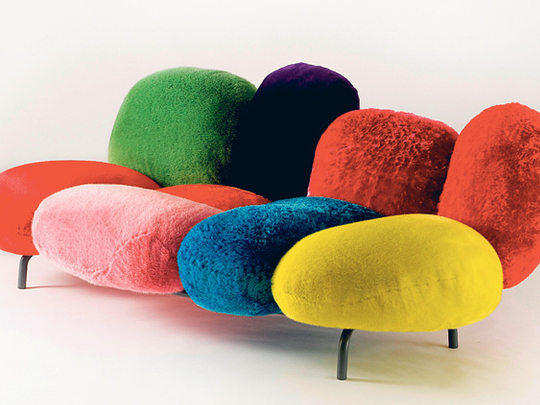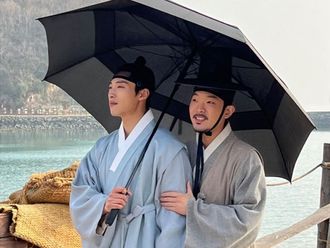
Renowned Brazilian designers Humberto and Fernando, collectively known as The Campana Brothers, whose works have graced many international venues and galleries, were recently in town to attend the second annual Abu Dhabi Art, which ran from November 4 to 7.
Weekend Review caught up with the brothers to discuss the installation they were commissioned to create, their thoughts about the capital and what their dream projects would be.
"This wasn't the first time we participated in Abu Dhabi Art. We presented a discussion two years ago [when Abu Dhabi Art was known as Art Paris Abu Dhabi], which was an interesting experience. This year, we're here to present our commission by HSBC with two Emirati designers," Fernando explained.
The brothers collaborated with two Emirati artists, Khalid Shafar and Noura Al Muhairi, who worked at their studio, Estudio Campana, as part of a week-long cultural exchange organised by HSBC.
"We had actually designed a lounge for HSBC several years ago. When the person who was our point of contact for that project moved to Abu Dhabi, he approached us to be a part of the programme and we were more than happy to do so.
"When Khalid and Noura arrived, we explained the concept of our work to them, which is to merge form and functionality, and we began to brainstorm about what to create for Abu Dhabi Art," Fernando said.
The Campana Brothers are known for their quirky sense of style and design and have used materials ranging from brightly coloured plastic and carpet underlay to create decorative rolls that "upholster" a basic frame in their Sushi collection (2002-2004) to combining glass with Brazilian dolls and other materials to various chandeliers and sculptures for Glass Experiences (2010) with Italian glass brand Venini in the former coach house at Waddesdon Manor in the United Kingdom.
"We are inspired by daily life and the materials we find. We make it a point to use humble material such as plastic bags so we can somehow change them into something more precious.
"The streets of our city, São Paulo, always provide us with unexpected inspirations and ideas for materials we can use in our work," Humberto said.
"Also, design nowadays is about concept and history. It creates a photograph of the environment it was conceived in or the environment it was meant to reflect," he added.
The designers revealed they were amazed by the level of enthusiasm displayed by the two young Emirati artists as they began discussing and working on the installation they were commissioned to create for the art fair.
"We agreed on using Islamic geometric patterns with cardboard and even though they were only with us for a week, we were very impressed with their ideas and how they created the installation.
"They were brilliant and enthusiastic. We were able to exchange cultural and design ideas and became friends by the end of their stay with us," Humberto said.
"Both Brazil and the UAE don't have a history in design and because of that, there is always a great curiosity to constantly do better. There's no influence or corruption from the more established designs," he added.
They also noted that as they interacted with Khalid and Noura, Humberto and Fernando realised that Emirati and Brazilian cultures have several similarities, including their approaches to design.
"In the UAE, like Brazil, crafts workers are very hands-on when creating their works but unfortunately, this tradition is dying out.
"We are trying our best to preserve and increase interest in these techniques, but there is a great potential in the UAE to enhance these methods and evolve them in a way that is unique to the country," Humberto said.
Both revealed that they are interested in returning to the capital and creating something unique in Abu Dhabi.
"It would be wonderful to create something with palm trees and dates. I would love to investigate the process of weaving used here and what materials are used. Can you imagine a palace constructed from only those materials and using traditional Emirati techniques? It would be magnificent!" Humberto said excitedly.
"Unfortunately, we weren't able to stay longer and properly explore the art fair and even see how the city has changed since we left.
"I would really love to have the chance to come back for a longer stay and explore all the different aspects of the culture here, such as the fishing villages," he added, wistfully.
Fernando agreed, revealing that some of the experiences during their second visit had inspired them to find a way to return in future.
"During our short stay in Abu Dhabi, we were able to visit the Shaikh Zayed Mosque. It was amazing to see how rich and intricate the designs are. We also had the chance to eat at a traditional Emirati restaurant.
"The fact that they use their hands to eat and the environmental materials they use, such as the shells that were hanging on the walls, were beautiful and we were very happy with the way they treated us, like we are human beings and not in a robotised way like in many restaurants, especially the fast food ones," he said.
Both brothers admitted that being designers was not something they had intentionally pursued. Humberto, born in the Rio Claro area of São Paulo in 1953, studied law but began to design furniture in the mid-1980s after Fernando, born in Brotas in 1961, had completed his architectural degree.
"It's funny, our family is essentially bourgeois and wanted us to be lawyers, engineers. I studied law and after I graduated, I gave our parents my diploma and told them now it was my turn to live my life. I opened a small sculpture studio and Fernando joined me.
"Our parents were shocked at the path we were going down when we first started but now they're proud of what Fernando and I do," Humberto said.
Still, when asked whether they had ever argued about what to create and with which materials, both brothers chuckled.
"We do that a lot. We both have very strong personalities and are very stubborn, so we tend to fight a lot when we work on our projects," Fernando said.
"But at the same time, there's always something that comes up that causes us to reconsider something or take the original idea in a different direction. That's the nature of creative work."
While their unique collaborations have made them a fixture on the design and even the art worlds, each harbours a hope that one day he will be able to work on individual projects close to his heart.
"My dream is to create a garden because Brazil has a very rich landscape and our forests look like a garden but I'm not sure what materials I would use," Humberto said.
Fernando laughed, adding: "My dream is to create a completely transparent aircraft out of glass so people can see exactly what makes it up and how it works because aircraft fascinate me."












